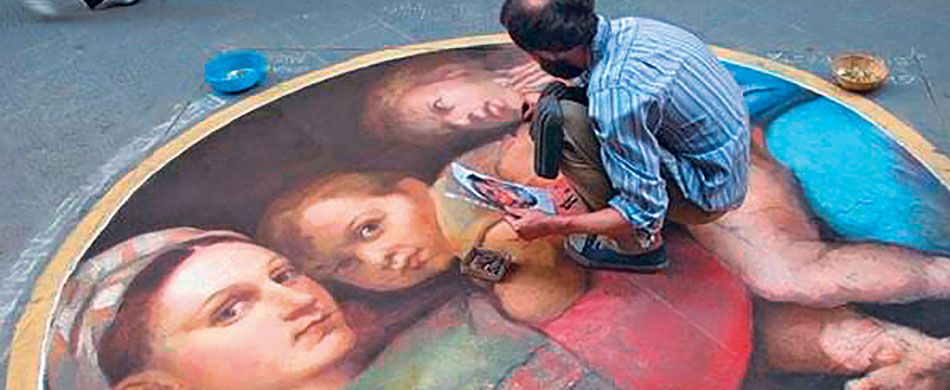Dear Friend, have you ever heard of the Madonnari? They are itinerant artists who create their beautiful drawings on pavements such as streets, sidewalks and town squares using colored chalks. In many countries they are simply called “street artists,” but here in Italy they are called Madonnari because their favorite subject is the Madonna, that is, Our Lady.
Currently there are a number of important festivals in various parts of the world where these unusual artists can exhibit their works; the oldest of these is held in the town of Curtatone in northern Italy, but there are many others in Germany, the United Kingdom, the States, Israel, Mexico…
Yesterday I came across one of these artists, Antonio, who was working in one of the squares here in Padua. A 40-year-old man, he was crouching on the ground with a chalk box next to him, completing a stylish copy of Raphael’s Madonna of the Chair.
I struck up a conversation with him, and I was able to learn that the life of a Madonnaro is certainly not an easy one. In fact their work, besides being hard and demanding, very much depends on the weather. “You often start on a theme under a sweltering sun,” he said, “and you have to sit in uncomfortable, twisted positions in order to get your work done properly and not destroy it with a false movement. Then perhaps a big drop of rain comes down, or a storm overtakes you, and the image is botched or flows down the drain. But it is precisely this fleeting nature of our works that make them so unique, only similar to theatre or music. Our art is based on the emotion that passers-by receive when they catch a glimpse of our works; they then move on, and maybe a sweet memory or tender feeling remains in them.”
But the public is not always kind to these artists; sometimes there are people who, for whatever reason, feel offended by their works, and therefore ask public authorities to have their images wiped out, charging them with ‘illegal occupation of public space’. “It is really sad, you know, to have to cancel your own work after having labored at it with dedicated love for hours on end,” he told me.
Antonio began street painting almost by chance when he happened to meet a Madonnaro in the main square of his city. He had always loved drawing, and so he decided to become a Madonnaro himself. He bought some colored chalk and, after learning the basic art techniques by following step-by-step instructions and painting tips from the artist he had met, he continued on his own. “I immediately felt like a real artist” he told me; “On the one hand there were the technical factors, like that of drawing on pavement and laying down the color, on the other hand there was the human factor, that is, the interaction with onlookers, either experts or simple passers-by.”
Antonio soon realized that if he painted the Virgin Mary, he would receive more donations than usual, and moreover they almost never asked him to cancel his works. However, despite these benefits, Our Lady gradually became his favorite subject because, even if our world is often insensitive and greedy, there are still many people who, upon seeing an image of the Virgin Mary painted on pavement, are moved to tears. Maybe this is due to the fact that they see in that image a gaze, an embrace, a tenderness and empathy which are increasingly missing in our modern societies, but which continue to resonate deeply in their hearts and souls. It is no mere chance that we turn to Our Lady when we need to feel welcomed, protected, listened to and helped.
While he is busy placing the finishing touches on Our Lady’s face, Antonio often finds himself immersed in prayer: “So in a certain sense my works end up being the result of my prayers.”
Devotion, passion and talent are the principal traits of these extraordinary street artists. Through their capacity in reproducing sacred images of stunning beauty, the Madonnari become powerful, effective street preachers who are able to communicate the unquenchable love of God from city to city, from town to town, for Mary is closely tied to the greatest sign of God’s love – the Word Made Flesh who took upon himself our sins and weaknesses.




